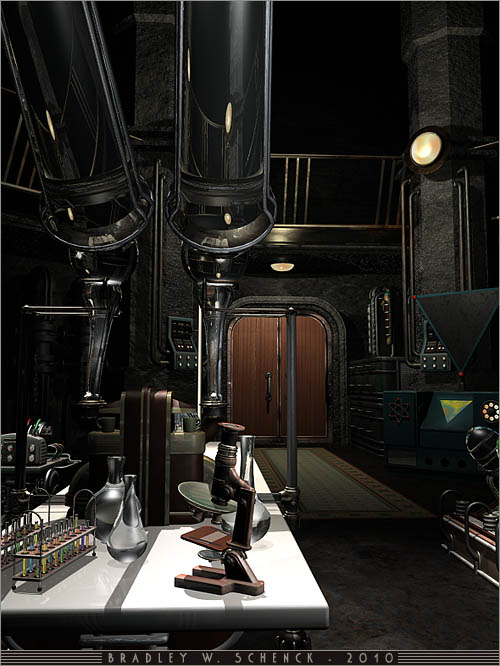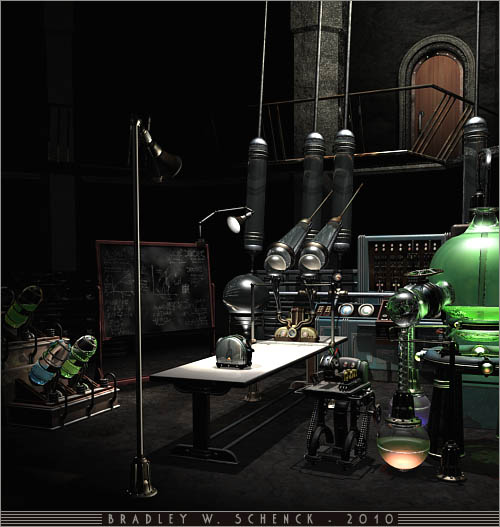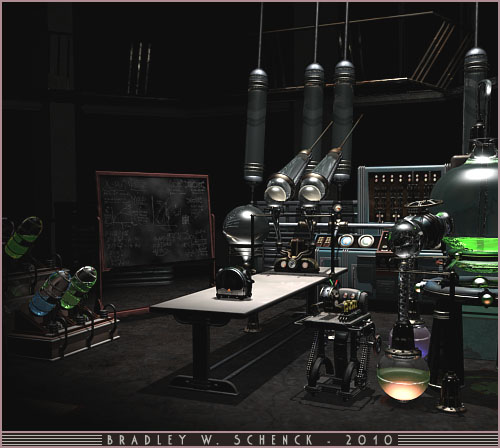
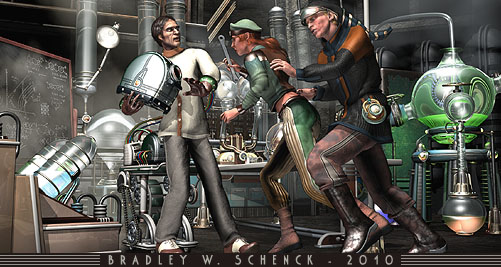
As Gwen and her wrench have a strange interlude in the laboratory of Doctor Rognvald, I seem to be about 75% through with the illustrations for Part One of The Toaster With TW0 BRAINS. That’s nineteen more pictures to go (ten of them set here in the laboratory) plus a couple of redos, and then a little more mechanical work on the Thrilling Tales of the Downright Unusual web site before it’s ready for the public.
What a long haul!
As I’ve worked on this first part – Trapped in the Tower of the Brain Thieves – I’ve learned some things about what will and won’t work well in the format. And about scale: the density of the illustrations is nowhere what you’d find in a comic, but there are still a lot of pictures and they do take time. TWO BRAINS will likely continue in a very similar way but in the future I may try to do shorter story segments just to make sure that the site gets more than seasonal updates.
For reference: I spent a week on the script. Although I’ve edited it some since then, it was pretty well settled at the end of that week. But in order to finish the eighty-odd illustrations I’ve kept at it almost continuously since late August. So at that rate even "seasonal" is a bit optimistic, isn’t it?
And I’ve wrestled a bit with style since at the beginning, knowing what a long road was ahead, I was determined to work out ways to get the pictures done speedily. I’ve pretty much abandoned that by now and I’m more in my usual mode of "It’ll be ready when it’s ready". But there just has to be a middle ground for something of this scale.
Anyway I do hope it works out between the free web versions and the printed book versions – and that I sell a few of the books! The great thing about making so many illustrations is that there’s a handful of them that I want to redo at, say, 18 by 24 inches for posters and prints. Along with preparing the print version and working on Part Two…!
Update: the Thrilling Tales of the Downright Unusual web site is now alive (alive, I tell you!) at thrilling-tales.webomator.com
This entry was posted on Sunday, January 31st, 2010
and was filed under Thrilling Tales of the Downright Unusual, Works in Progress
There have been no responses »
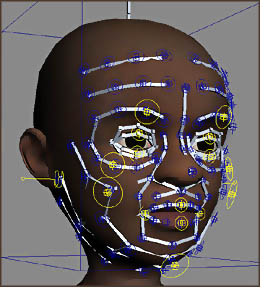 A demo version is now available for Fx Lda and Scriptattack’s Bonyface system.
A demo version is now available for Fx Lda and Scriptattack’s Bonyface system.
This looks like a really promising tool for setting up facial rigs in 3D characters, animating or posing them, and then storing expressions the same way you might store morph targets, in a library.
What I really like about it is that there’s an underlying network of splines which you fit to the surface of your model. Along the splines there are bones which you use to skin the model to the rig. Then there are a smaller number of controllers that move the splines around… which move the bones around… which move the face around. There’s a fine level of control where it’s needed while you’re given a high level system for using that control. Yet the setup of a character’s face is just a matter of editing those splines to match the model.
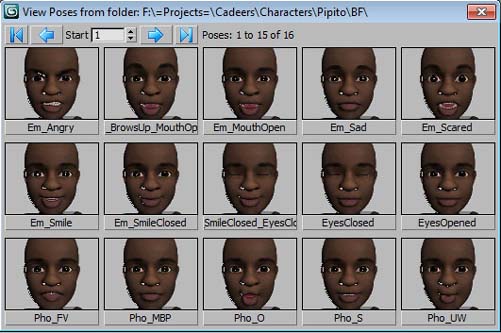
Skinning is always traumatic for me because it takes me forever and, truth be told, I’m just not that good at it – and faces are one of the most difficult parts of a character to skin. So when I tell you that this looks like a very clever and powerful tool for 3DS Max… well, I’m coming from a highly motivated place.
And a disinterested one, unfortunately! The script doesn’t claim to be compatible with versions of 3DS Max older than Max 2008, and I’m running on an older version. Something like this might make me a lot more interested in an upgrade.
Found via Max Underground.
This entry was posted on Thursday, January 28th, 2010
and was filed under Computer Graphics
There have been no responses »
Once upon a time in a career far, far away, my then co-conspirator Michal Todorovic and I were working in game development. Our publisher was Electronic Arts – which, even then, was an eight hundred pound gorilla in a stylish suit.
EA had started out as a company that went out of its way to honor its creators. It practically rolled in its creators. Creator photos and bios appeared inside every one of its unique, album-shaped packages. EA was near and dear to the hearts of the gaming public and of developers, to boot, who in those days were practically two sides of the same coin.
There was a time when a couple of people could walk into EA and walk out with a contract. I know. It happened to us. Of course when we got back to the hotel we realized that the contract they’d given us was a work-for-hire contract and Job One was to tear that puppy up and tell them to try again.
Because EA was changing, and in fact had changed, by the early 1990s. They were doing less and less internal development. They were doing more and more producing of titles that were developed at the little startups who still thought they might survive in what was rapidly becoming a very big business.
And as a result, the people at EA were changing. You didn’t see as many people who had actually made games. You saw more and more who had only worked in game production, which isn’t the same thing. So while we didn’t know it, this was the beginning of that trend in which game testers would by stages be promoted to game producers, ensuring that no one who oversaw game projects would have any experience in making the things. And that the people who would give you valuable feedback on a game’s design had never designed a game. But they thought they had: they were Electronic Arts, weren’t they? And they never realized that they weren’t the same Electronic Arts that had done the wonderful things they thought they’d done.
None of this was really obvious at the time. There was just this puzzling state in which it was clear that something was different.
In the course of hammering out a real contract we needed to write documentation that described what the project was and how we’d overcome its challenges. Perfectly reasonable if you wanted the company’s money, which we did. I worked on the design documents, and Mike worked on the technical documents, and everything – we thought – was going pretty smoothly.
We’d been working on our game (The Labyrinth of Time) for about a year already, so we had a pretty good idea what it was, how it worked, and what we still needed to do. I’d created a complete game design document already. That included several sections of the game that could be deleted, if necessary, and the steps we’d need to take to patch the holes those sections left.
Then the most important of the technical documents came back from its reviewer. Well, okay: what did we need to add, or do differently? He didn’t know. He hadn’t read it. His complete review was: "It feels light. There’s not enough there."
Mike wasn’t sure what to do about that – especially since what he was writing about already existed, and, well, he’d documented it. So since this was a matter of presentation, he asked for my advice.
We looked over the document. We increased the font size. We increased the spacing between the lines. We added one paragraph. We printed it out on thicker paper. The new document spanned more pages and each of those pages weighed more than the old ones had.
When the technical director got the new version, he said "Yes, this looks much more complete."
I don’t think we acted dishonestly. The document had been rejected, unread, on the grounds that it "felt light". So to fix the problem we made the document heavier. Everyone wins!
But the story didn’t end there. The document was kicked back again because of one required section in which we had to describe the problems we had not anticipated, and then explain how we would overcome those problems.
Let’s review that, shall we?
We had to describe the problems we had not anticipated. The problems that, by definition, we did not know were there. And then explain how we would solve those problems. Of which we were – again, by definition – completely ignorant.
I’m not sure how we described the things we did not know about, but our plan for overcoming those obstacles was:
We will crush our enemies, drive them before us, and hear the lamentation of their women.
Problem solved: that version of the document was accepted.
This entry was posted on Thursday, January 28th, 2010
and was filed under Can't Stop Thinking
There have been no responses »
Over the years the Universe has now and then slapped me upside the head with a reminder that the world is a strange and wonderful place. Because, you know, it is. And it’s easy for us to forget that, isn’t it? So although I’ve never made a point of thanking the Universe for those little revelations, well, here I go: thanks, Universe!
In every decade since the 1970’s I’ve told myself that the 1970’s did not count. I was a teenager then. As far as I’m concerned that decade was pretty much a warm-up exercise. So if you’ll agree with me about that – that what happened in the 70’s stays in the 70’s – I’ll tell you a story.
(more…)
This entry was posted on Sunday, January 24th, 2010
and was filed under Can't Stop Thinking
There has been 1 Response »
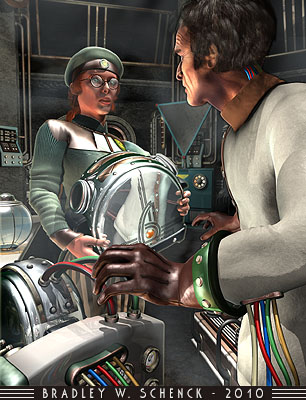
"Then his eyes fell on the toaster, and he stepped forward eagerly. Gwen held it out at arm’s length. She was pretty happy to keep the doctor as far away as possible. As he lurched forward, the rolling tray creaked after him with its smaller, modified toaster. She could clearly see the cables that ran up his sleeve and then – she was sure! – out of his collar at the back of his neck. Where they went from there, she told herself, was absolutely none of her business."
Update: the Thrilling Tales of the Downright Unusual web site is now alive (alive, I tell you!) at thrilling-tales.webomator.com
This entry was posted on Saturday, January 23rd, 2010
and was filed under Thrilling Tales of the Downright Unusual, Works in Progress
There have been no responses »
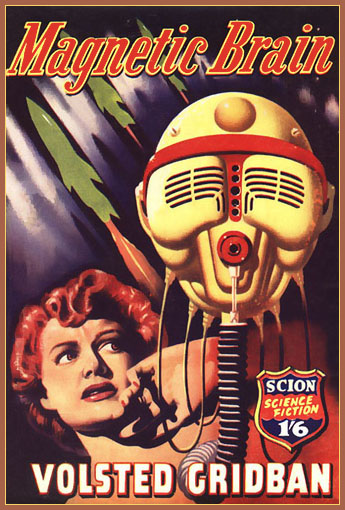
Because nothing says "Thursday" like a well-coiffed woman being terrified by a magnetic brain.
This entry was posted on Thursday, January 21st, 2010
and was filed under Found on the Web
There have been no responses »
I spend most of my days inside my own head. I admit it. I’m not ashamed. But usually I make the time to pop my metaphorical head above the waters, notice interesting things, and jot them down in here.
Lately I’ve been keeping that head down a bit more than usual because what I’ve been immersed in is not a metaphor: it’s just a great big project that I hope to finish soon. Ish. So today, here are a couple of things I’ve meant to share… but haven’t. After which – head down, full speed ahead, silent running.
Greg Brotherton’s New Museum Show
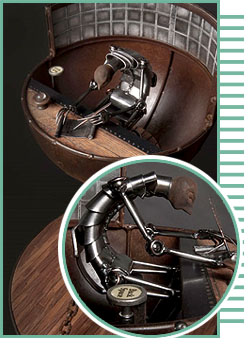 I’ve written before about Greg Brotherton’s sculptures, which are remarkable pieces that combine found objects with new metals, wood, and other materials.
I’ve written before about Greg Brotherton’s sculptures, which are remarkable pieces that combine found objects with new metals, wood, and other materials.
His newest work is now on display in a show called Discoveries in Dystopia at the Oceanside Museum of Art, near San Diego in California. The new work concentrates on dystopian views of workers in fascinating but forbidding settings: cubicles, desks and machines that enfold their laborers in Sysiphean toil.
Like Brotherton’s other works the textures and their contrasts are lovely to the eye and there are occasional grace notes (like the "Back Space" typewriter key shown here) that reward the careful observer. Wonderful stuff!
The museum’s show runs through March 19, and there’s a "Meet the Artist" event on February 6.
ATOMIC ROCKETS Web Site
If you’ve seen my own work, you may have guessed that of all the things I may be about, scientific accuracy is, well, absent. If I can fool you into thinking that a thing might work, well, job done, right? Because things like open cockpit roadster "rockets" aren’t the most practical or likely sort of vehicles in the first place.
 On the other hand, I appreciate scientific accuracy in science fiction (which is not exactly what I do, anyway). Authors can get away with fooling me, too, but they have to work at it a bit if what they’re doing is cast in a realistic mode.
On the other hand, I appreciate scientific accuracy in science fiction (which is not exactly what I do, anyway). Authors can get away with fooling me, too, but they have to work at it a bit if what they’re doing is cast in a realistic mode.
So I was delighted on a couple of levels when I discovered the Atomic Rockets web site. It doesn’t hurt for me to get a little better at fooling you, after all, and the material’s pretty interesting in its own right.
Because Atomic Rockets is a large and growing compilation of information about how spaceships and related technologies actually need to work, and why. The examples are a mix of real aerospace experience and research with science fiction examples – good, bad, and ugly – from decades worth of fiction and movies.
And there are plenty of equations to help you to calculate whether your own space ship is going to be able to make that trip to Neptune. If not, you can research some of the other types of propulsion!
So I’ve made plenty of discoveries there already and look forward to more. The site is the ongoing project of Winchell D. Chung Jr. – have a look!
This entry was posted on Wednesday, January 20th, 2010
and was filed under Found on the Web, Hodgepodge
There have been 6 Responses »
I’ve spent some time working at the far end of the laboratory, and pretty well wrapped that up and added some clutter here, at this end of the table. Finicky, finicky.
The dusty old Interociter doesn’t have a thing to do with the story; odds are Doctor Rognvald just picked it up second hand. You find those things in labs all over the place, of course.
I really need to wrap his one up soon. I keep making the mistake of approaching my test views as though they were actual pictures, which leads to all sorts of little adjustments that simply waste my time until I catch myself at it.
Another day or two and I’ll have to set the laboratory aside while I work on the last couple of props I’ll need in there… and then – finally! – I can concentrate on the illustrations themselves.
Out of all the crazy stuff in here I think I’m getting my biggest kick from the high voltage Frankenstein switches with all their gauges and dials, which only serve to flick the lights on and off.
Update: the Thrilling Tales of the Downright Unusual web site is now alive (alive, I tell you!) at thrilling-tales.webomator.com
This entry was posted on Friday, January 15th, 2010
and was filed under Computer Graphics, Thrilling Tales of the Downright Unusual, Works in Progress
There have been no responses »
I’ve worked out the basic lighting setup for Doctor Rognvald’s lab, and added practical light objects to match them (well, except for that door up on the catwalk, anyway). So far I’ve only got one "cheat" light in here – that’s premature, really, since I’ll mainly add the cheat lights when I’m setting up shots for the illustrations I need. But I wanted a little rim light on that floor lamp.
What we’ve got here is a pretty realistic general lighting setup that I’ll mutate and change and modify for the individual shots I need for the story.
What’s left to do is to add two more light fixtures, and then have a look at the camera angles to decide what other clutter I need on the table, and what indistinct shapes I want to add in the shadows… at which point the lab itself will be pretty much done, and I can move onto a couple of important props. Altogether I’m dangerously close to being able to make pictures in here. Muahahahahaha!
The more time I spend in here the more I find that I’d kind of like a room like this to work in. It’s well equipped: you can’t tell in this shot, but that’s an espresso machine at the far end of the table. What more do you need?
The downside of working on a project of this scale is that it takes so long to get everything done. But part of the upside is that I’ll have such cool sets and props to use in other pictures. I know I’ll want to revisit this lab when I can. I’m really looking forward to making poster-scale images of this one.
Even at high res, though, you’ll never be able to make out the ridiculous labels on the dials and buttons. There’s a "Hyphenation" dial, not to mention the "% Froglike" one. I guess those are just for me.
Update: the Thrilling Tales of the Downright Unusual web site is now alive (alive, I tell you!) at thrilling-tales.webomator.com
This entry was posted on Wednesday, January 13th, 2010
and was filed under Computer Graphics, Thrilling Tales of the Downright Unusual, Works in Progress
There have been no responses »
Here’s where ‘ve been for the last… oh, I have no idea. It’s the laboratory of mad Doctor Rognvald, creator of the Toaster With TWO BRAINS. It’s the second mad scientist’s lab I’ve built for this Thrilling Tale. The two are quite different.
That’s because Cornelius Zappencackler’s lab is sort of a pleasant place for tinkering – one that you or I might like to work in. Oh, you’re right – some of the things he gets up to in there do sort of threaten to destroy the planet. But he’s an affable old gent, and he means well.
Okay. Maybe "well" isn’t the word I was looking for. But he doesn’t mean harm. It’s just that sometimes harm happens anyway.
But this! This is a laboratory that you or I might like to tinker in only if we were evil geniuses! This place is a textbook example of the kind of room where you Meddle In Things That Man Was Not Meant To Wot Of! This is the sort of lab where every now and then you just have to throw your head back and crow: "It’s ALIIIIVE!"
I’ve been having a great time with the glassware and instruments. This is just the point where I’ve dropped a real light source into the scene so I can get an idea of what to do next; but it’s well on its way… it’s…. nearly…. aliiiiive!
See what I mean?
Update: the Thrilling Tales of the Downright Unusual web site is now alive (alive, I tell you!) at thrilling-tales.webomator.com
This entry was posted on Tuesday, January 12th, 2010
and was filed under Computer Graphics, Thrilling Tales of the Downright Unusual, Works in Progress
There has been 1 Response »


















